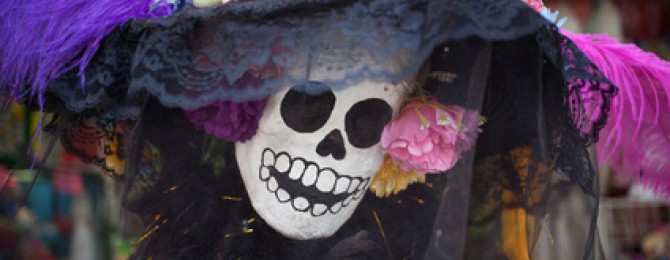Different celebrations, one theme: Death
Vom 30/10/2015
Death is not a very cheerful topic. People are often afraid of it or treat it with a certain reverence, but our relationship with it throughout history has led to the development of various traditions and festivals, and in this article we will to have a look at three ways of celebrating death today: Halloween, All Saints’ Day and the Mexican celebration “Día de los Muertos”.
Halloween has become one of the most comercialised events of the year with its pumpkins, fancy dress and famous “trick or treat”, but the celebration has pagan origins dating back to Samhain, a Gaelic festival that marked the end of summer and arrival of winter.
It was already associated with the supernatural and the dead and it was believed that fairies and spirits could cross over into our world more easily at this time; other noticeable similarities with Halloween include the tradition of dressing up and going from door to door asking for food. Many superstitions, legends and traditions also developed around Samhain such as Jack O’Latern, the famous carved pumpkin. It was celebrated on the night of 31st November, before it was combined with All Saints’ Day (not to be confused with All Souls’ Day, on 2nd November) in 835 under Pope Gregory IV.
All Saints’ Day, the 1st November, is a Christian celebration held in honour of all saints. Today it is much less widely celebrated that Halloween, although in France and Spain it is a national holiday and some take the opportunity to visit the graves of loved ones.
In Mexico, on the other hand, diverse and colourful celebrations are held on 2nd of November, which is the Día de los Muertos, or “Day of the Dead”. The festival is also gaining popularity in Europe, rivalling Halloween thanks to its originality (skeletons dressed in traditional clothing) and the star of the show, La Catrina, a female skeleton who symbolises death, not to mention the altars and offerings made to the dead and the candy skeletons. It is also an opportunity for Mexicans to visit the graves of friends or family, but in a much more light-hearted spirit, often picnicking next to the grave.
We hope this short summary of multicultural celebrations has given you a better understanding of the origins of all the disguises and events planned for this weekend.
Beware of skeletons looking for sweets, treats and chocolates on your way home at night!
Beiträge nach Standort sortieren :
Auf der Suche nach einem bestimmten Thema? Versuchen Sie es mal hier :
